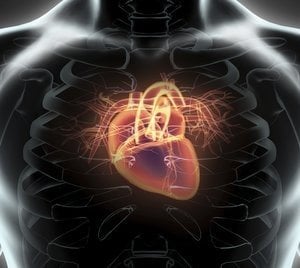
For many people, mitral valve prolapse (MVP) is discovered during a routine exam. Your doctor may hear a distinctive murmur or “click” in the stethoscope that signals mitral valve prolapse. The good news is that it’s a common, and usually benign, condition.
What exactly is mitral valve prolapse? The mitral valve is one of four valves in your heart. It’s located between the left atrium and the left ventricle—and is called the mitral valve because it’s the same shape as a bishop’s miter, or headpiece.
The mitral valve’s job is to regulate blood flow. Specifically, the mitral valve has two flaps that are supposed to open freely and far enough to allow blood to enter the left ventricle. Then, it’s supposed to shut tightly enough to prevent blood from backwashing into the left atrium above.
If the mitral valve prolapses, or flops back into the left atrium, an unusual sound (cardiac click or murmur) is created by the blood leaking or "sloshing" in reverse mode. Usually, a thickening of one or two of the valve's leaflets causes this prolapse.
You can think of the mitral valve prolapsing like a sailboat catching the wind. That is, when blood travels through the mitral valve it may be caught in a billowing fashion like the sails of a boat filling with the breeze.
While the diagnosis sounds ominous, mitral valve prolapse is more common than you might think. It affects approximately 4% of the population, and the good news is that 99% of those with mitral valve prolapse have either no symptoms, or very mild symptoms and need no medical treatment at all. Why some people have mitral valve prolapse symptoms and others don’t remains a mystery.
What Are the Symptoms of Mitral Valve Prolapse?
The exact cause of mitral valve prolapse symptoms has not been fully explained. But increased adrenaline-like activity and magnesium deficiency are likely culprits. Those with mitral valve prolapse symptoms can experience:
- Fatigue and weakness,
- Dizziness and lightheadedness,
- Atypical chest pain,
- Shortness of breath with activity or while lying flat,
- Palpitations and cardiac arrhythmia,
- Loss of consciousness, called syncope (fainting) which is rare,
- Anxiety and depression due to the symptoms.
As with all cardiac symptoms, these can be quite alarming and uncomfortable for those experiencing them. So, the first step is isolating the problem.
Getting the Diagnosis
If your doctor picks up mitral valve prolapse during a routine physical, chances are he or she will tell you that it’s nothing to worry about and quite common. Both of these are true. But still, you may be wondering if you’re alright. Or, maybe the mitral valve prolapse symptoms were the reason you made the appointment in the first place.
If your doctor hears the telltale sounds of mitral valve prolapse, he or she will most likely order an echocardiogram to confirm the diagnosis. An echocardiogram shows a moving picture of your heart's valve structure, and can show whether or not the mitral valve does indeed prolapse. The echocardiogram will usually show more details as well, including sagging or stretching of the mitral valve, or even leakage (mitral regurgitation).
If you have been having palpitations, or your doctor identifies a cardiac arrhythmia on an electrocardiogram (EKG), you may be asked to wear a 24-hour Holter monitor and keep a diary of your symptoms. The mitral valve prolapse symptoms will be ranked as mild, moderate, or severe based on these tests.
Natural Therapies Are Very Effective for Treating Mitral Valve Prolapse Symptoms
Even though beta blocking drugs can ease some of the distressing mitral valve prolapse symptoms—particularly sudden onset jabs of knife-like chest pain or irregular heartbeats—they don't always work for everyone. Plus, people often complain about the side effects of beta blockers. That's why I hesitate to turn to pharmaceuticals, and look first to non-drug interventions.
Before I deploy the heavy guns, I usually ask my patients to try a metabolic cardiology approach which includes coenzyme Q10 (CoQ10) (50 mg twice daily) and magnesium (200 mg twice daily). In my cardiology practice, more than half of my patients with mitral valve prolapse symptoms responded well to the combination of CoQ10 and magnesium. They had less chest pain, shortness of breath, and irregular heartbeats. In fact, approximately 60-70% of my patients with mitral valve prolapse did well with these simple interventions, reporting a decrease in symptoms, especially arrhythmia.
For those with moderate to severe mitral valve prolapse, I added L-Carnitine (500-1,000 mg daily) and D-ribose (5 grams once or twice daily) to enhance overall energy production and cardiac functioning. I also recommend squid or fish oil (1-2 grams daily) to help prevent clots and inflammation.
It’s also important to avoid foods that can trigger mitral valve prolapse symptoms, including sugar, caffeine, and alcohol. Instead, I recommend following a diet that’s low in sugar like my Pan-Asian Modified Mediterranean (PAMM) diet. The PAMM diet also includes many foods that reduce the chronic inflammation component of mitral valve prolapse.
Sometimes Medications Are Necessary
I have seen dietary interventions and nutritional supplements work very well in assuaging mitral valve prolapse symptoms, and they are also advisable for those of you who do not have symptoms.
When I did have to rely on medicine to treat troublesome arhythmias or chest pain, I usually prescribed the beta blocker Toprol in various dosages, depending upon the person's response. Beta blockers calm the heart by blocking the effect of adrenaline—the hormone that can make the heart pound harder and faster.
Women, especially those in menopause, may require additional interventions. That’s because the drop in estrogen that occurs with menopause can worsen mitral valve prolapse symptoms. I've found that estrogens or natural phytoestrogens can help ameliorate some of these menopausal symptoms. I prefer bioidentical hormone replacement therapy over synthetics.
Also, postmenopausal women are more likely to develop diastolic dysfunction, a condition that is caused by mitral valve prolapse. If you suspect, or know, you have mitral valve prolapse you want to get a good medical workup. Maintaining healthy blood pressure can also help to prevent a worsening of the condition.
One final note about mitral valve prolapse. If you have mitral valve prolapse and a leaky valve, you want to take prophylactic antibiotics before dental or other surgery to prevent infection of the vulnerable valve.


